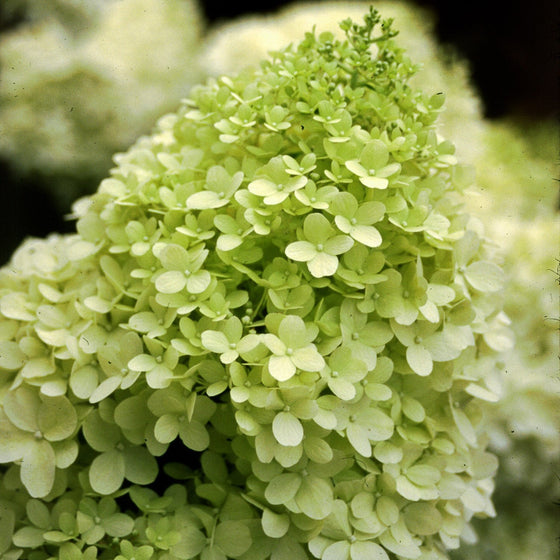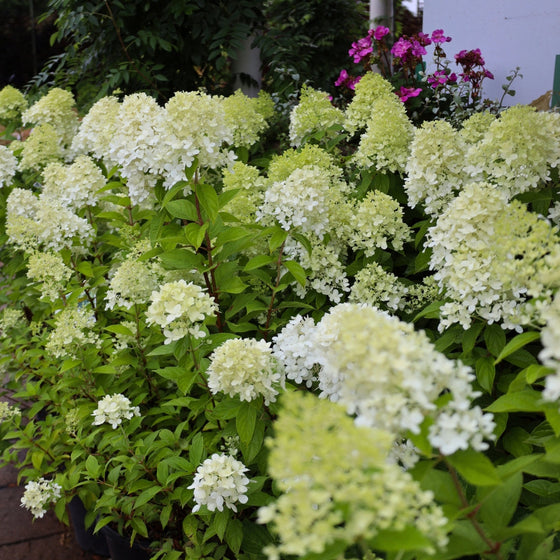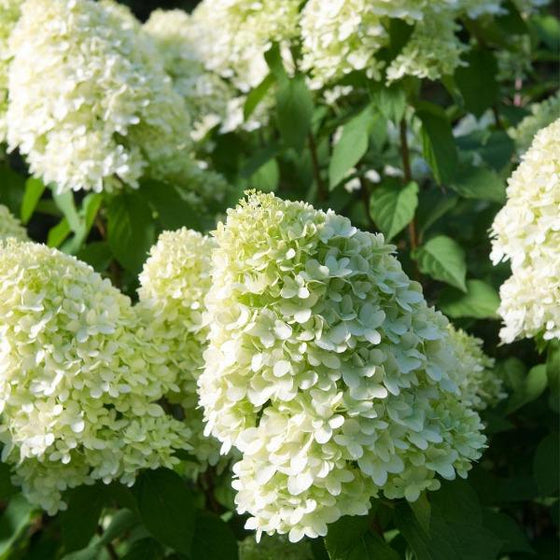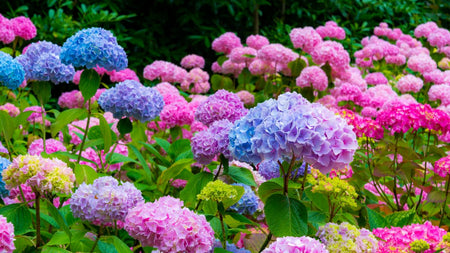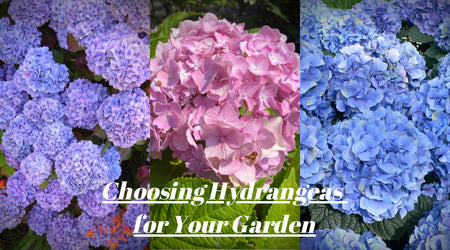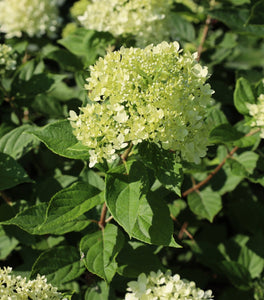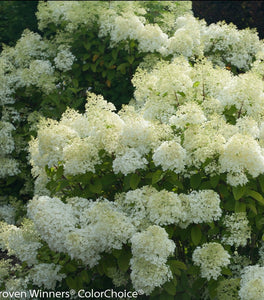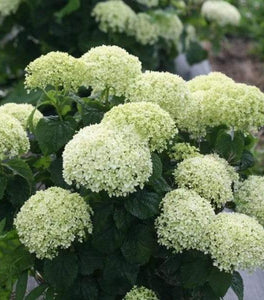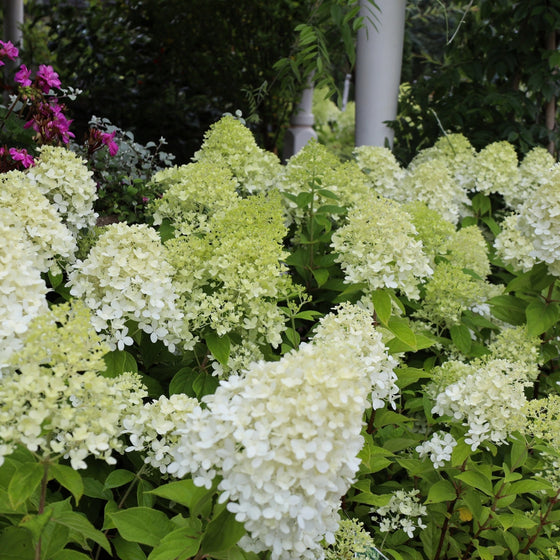
Images Depict Mature Plants
Limelight Hydrangea – Hardy Panicle Hydrangea with Lime-Green Blooms that Last All Summer
Big color, bold blooms, and unbeatable reliability.
The Limelight Hydrangea (Hydrangea paniculata ‘Limelight’) is a garden showstopper with enormous cone-shaped blooms that start lime green, fade to creamy white, and finish the season in soft blush-pink. Known for its strong stems, reliable performance, and cold-hardiness, this panicle hydrangea is a landscape favorite across the U.S. From large borders to foundation plantings, Limelight brings long-lasting beauty and drama to every garden.
A statement shrub with four-season interest.
Growing 6 to 8 feet tall and wide, Limelight Hydrangea is ideal for hedges, privacy plantings, and mixed perennial beds. The lush blooms appear in midsummer and last through fall, even drying beautifully for winter arrangements. Its upright, architectural form and deep green foliage provide structure and balance, making it an anchor plant in both formal and naturalized designs.
Built for strength, cold, and performance.
Unlike many flowering shrubs, Limelight Hydrangea thrives in full sun to partial shade and handles heat and cold with ease. Hardy from Zones 3 to 8, it’s one of the most adaptable hydrangeas available. The sturdy stems never flop, even under the weight of massive flower clusters, and the plant’s vigorous growth ensures lush coverage in just a few seasons.
The Gold Standard in Hydrangeas.
Whether used as a standalone specimen, a foundation accent, or a mass-planted hedge, Limelight delivers unmatched reliability and show-stopping impact. Its vibrant blooms, tough constitution, and minimal maintenance requirements make it a top choice for both professional landscapers and home gardeners seeking effortless elegance.
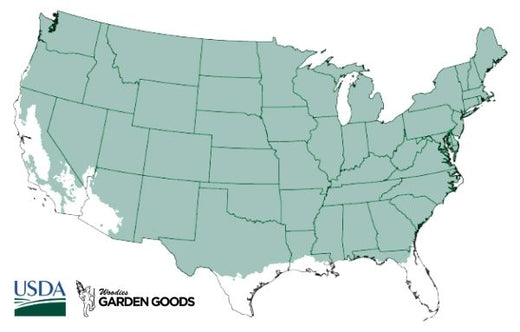
| Hardiness Zone: | 3-8 |
|---|---|
| Mature Height: | 6 to 8 feet |
| Mature Width: | 6 to 8 feet |
| Classification: | Broad leaved deciduous shrub, summer flowering |
| Sunlight: | Full sun to part sun |
| Bloom season: | Mid summer to fall |
| Habit: | Upright mounding, densely branched |
| Flower Color: | Pale greenish white flowers in summer, turning light pink to rose or burgundy in fall |
| Foliage: | Dark green |
| Pruning Season: | Late Winter to early spring, promotes increased branching and more flowers |
| Soil Condition: | Any well drained soil |
| Water Requirements: | Water well until established |
| Uses: | Extremely attractive when used as a focal point in the mixed border, mass planting, specimen planting or containers; dried flowers create winter interest |
How to Care for Limelight Hydrangea
Be sure to read our planting instructions to ensure a healthy and happy Limelight Hydrangea for years to come!
How do I plant a Limelight Hydrangea?
Plant your Limelight Hydrangea in well-drained soil with access to full sun or light afternoon shade. Dig a hole twice as wide as the root ball but no deeper. Set the plant so the top of the root ball is level with the ground, backfill with soil, and water thoroughly to settle the roots. Apply a 2-3 inch mulch layer to conserve moisture and prevent weeds, keeping the mulch a few inches from the base to avoid stem rot.
How often should I water Limelight Hydrangea?
Water deeply once or twice a week during the first growing season to establish roots. Once mature, Limelight is drought-tolerant but performs best with consistent moisture. Avoid letting the soil dry completely between waterings. In extremely hot conditions, increase watering frequency. A mulch layer helps regulate soil moisture, ensuring vibrant blooms all season long.
When and how should I fertilize Limelight Hydrangea?
Feed in early spring with a balanced slow-release fertilizer (10-10-10). One annual feeding is usually sufficient for strong blooms and foliage. Avoid over-fertilizing, which encourages leafy growth at the expense of flowers. Healthy soil enriched with compost or organic matter often provides all the nutrients this hydrangea needs.

When should I prune Limelight Hydrangea?
Prune Limelight Hydrangea in late winter or early spring before new growth begins. Cut back stems by one-third to one-half to shape the shrub and encourage vigorous new flowering stems. Because Limelight blooms on new wood, it flowers reliably each year—even after hard pruning. Deadhead spent blooms to maintain a tidy appearance and prolong the season’s display.

